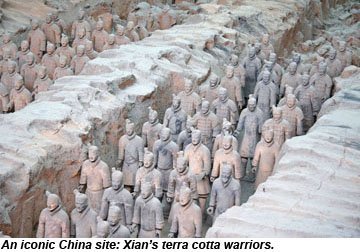Joan Jonat, a China travel specialist at Protravel International based in Harrison, N.Y., loves working with clients who already know the country and are ready to visit areas they haven't seen previously. If they are experienced, she said, there is more flexibility, and "we will do some tourist sites and we will include something that is just fun." "Just fun" for one family this June will be participation in the annual Shangri-La Horse Racing Festival in Yunnan province near the Tibetan border. » Read more »
» Read more » Explore the many amazing World Heritage sites throughout China. View our full blog post for more details. Imperial Projects (Pre-1368) Beautiful Mountains Religious Carvings Imperial Architecture (1368-1911) Natural Wonders Historic Towns Other Great Wall Taishan Mogao Caves Imperial Palace Jiuzhagou Lijiang Potala Palace Terracotta Warriors Huangshan Dazu Rock Carvings Summer Palace Huanglong Pingyao Confucius Family Mansion Dujiangyan Irrigation System Lushan Longmen Grottoes Imperial Tombs Wulingyuan Suzhou Wudang Temples Emeishan & » Read more »
» Read more »Over the past two thousand years, perceptions of distance and scale have been continually exploded by technological advances. We now take for granted: airplanes, trains and roads; distribution systems that furnish ice-cool “Perrier” in the midst of a vast, baking desert. Yet even now, Nature with a flick of her skirt belies our pretensions to mastery. When you’re in the middle of a scorching desert, there is only so much your air-conditioning unit can do. » Read more »
» Read more » These are the bare facts: the Mogao cave complex is comprised of 492 caves, containing 450,000 square feet of murals dating from the fourth to the fourteenth centuries – a period which corresponds to an immense growth in international commerce along the nearby Silk Road. The caves were abandoned in the fourteenth century and lay untouched until the beginning of the twentieth century. These facts presume ten centuries of consecutive public works programs of astonishing financial proportions and startling logistical complications. » Read more »
» Read more »By Guy Rubin Centuries ago, in a cliff-face in the midst of China's vast Taklamakan desert, artists hollowed, sculpted and painted 492 caves, creating over 450,000 square feet of spectacular murals, or more than thirty times the mural area of the Sistine Chapel. But whereas the Sistine Chapel was painted over a few years, the works at the Mogao Caves began in the fourth century and were completed over the next millennium. » Read more »
» Read more »



